Xiangyu Dong
SE-VLN: A Self-Evolving Vision-Language Navigation Framework Based on Multimodal Large Language Models
Jul 17, 2025Abstract:Recent advances in vision-language navigation (VLN) were mainly attributed to emerging large language models (LLMs). These methods exhibited excellent generalization capabilities in instruction understanding and task reasoning. However, they were constrained by the fixed knowledge bases and reasoning abilities of LLMs, preventing fully incorporating experiential knowledge and thus resulting in a lack of efficient evolutionary capacity. To address this, we drew inspiration from the evolution capabilities of natural agents, and proposed a self-evolving VLN framework (SE-VLN) to endow VLN agents with the ability to continuously evolve during testing. To the best of our knowledge, it was the first time that an multimodal LLM-powered self-evolving VLN framework was proposed. Specifically, SE-VLN comprised three core modules, i.e., a hierarchical memory module to transfer successful and failure cases into reusable knowledge, a retrieval-augmented thought-based reasoning module to retrieve experience and enable multi-step decision-making, and a reflection module to realize continual evolution. Comprehensive tests illustrated that the SE-VLN achieved navigation success rates of 57% and 35.2% in unseen environments, representing absolute performance improvements of 23.9% and 15.0% over current state-of-the-art methods on R2R and REVERSE datasets, respectively. Moreover, the SE-VLN showed performance improvement with increasing experience repository, elucidating its great potential as a self-evolving agent framework for VLN.
Chi-Square Wavelet Graph Neural Networks for Heterogeneous Graph Anomaly Detection
May 25, 2025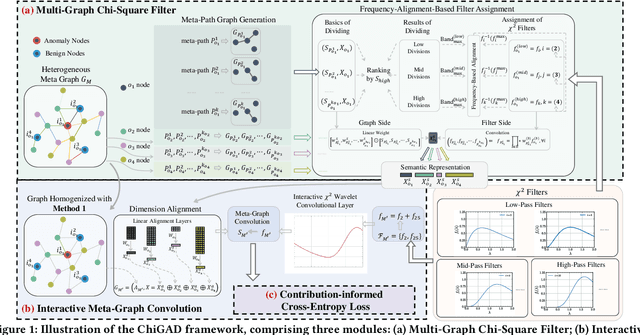

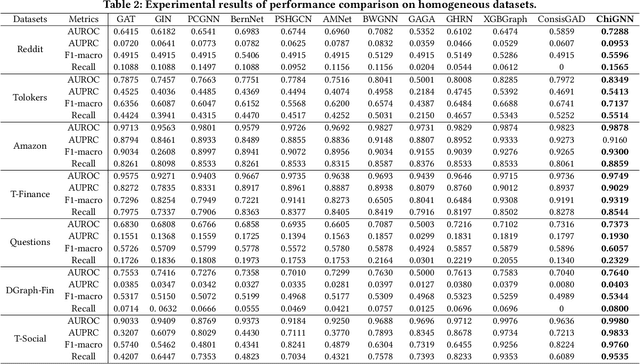
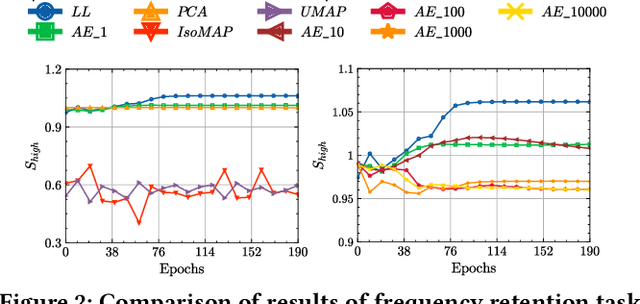
Abstract:Graph Anomaly Detection (GAD) in heterogeneous networks presents unique challenges due to node and edge heterogeneity. Existing Graph Neural Network (GNN) methods primarily focus on homogeneous GAD and thus fail to address three key issues: (C1) Capturing abnormal signal and rich semantics across diverse meta-paths; (C2) Retaining high-frequency content in HIN dimension alignment; and (C3) Learning effectively from difficult anomaly samples with class imbalance. To overcome these, we propose ChiGAD, a spectral GNN framework based on a novel Chi-Square filter, inspired by the wavelet effectiveness in diverse domains. Specifically, ChiGAD consists of: (1) Multi-Graph Chi-Square Filter, which captures anomalous information via applying dedicated Chi-Square filters to each meta-path graph; (2) Interactive Meta-Graph Convolution, which aligns features while preserving high-frequency information and incorporates heterogeneous messages by a unified Chi-Square Filter; and (3) Contribution-Informed Cross-Entropy Loss, which prioritizes difficult anomalies to address class imbalance. Extensive experiments on public and industrial datasets show that ChiGAD outperforms state-of-the-art models on multiple metrics. Additionally, its homogeneous variant, ChiGNN, excels on seven GAD datasets, validating the effectiveness of Chi-Square filters. Our code is available at https://github.com/HsipingLi/ChiGAD.
SpaceGNN: Multi-Space Graph Neural Network for Node Anomaly Detection with Extremely Limited Labels
Feb 05, 2025



Abstract:Node Anomaly Detection (NAD) has gained significant attention in the deep learning community due to its diverse applications in real-world scenarios. Existing NAD methods primarily embed graphs within a single Euclidean space, while overlooking the potential of non-Euclidean spaces. Besides, to address the prevalent issue of limited supervision in real NAD tasks, previous methods tend to leverage synthetic data to collect auxiliary information, which is not an effective solution as shown in our experiments. To overcome these challenges, we introduce a novel SpaceGNN model designed for NAD tasks with extremely limited labels. Specifically, we provide deeper insights into a task-relevant framework by empirically analyzing the benefits of different spaces for node representations, based on which, we design a Learnable Space Projection function that effectively encodes nodes into suitable spaces. Besides, we introduce the concept of weighted homogeneity, which we empirically and theoretically validate as an effective coefficient during information propagation. This concept inspires the design of the Distance Aware Propagation module. Furthermore, we propose the Multiple Space Ensemble module, which extracts comprehensive information for NAD under conditions of extremely limited supervision. Our findings indicate that this module is more beneficial than data augmentation techniques for NAD. Extensive experiments conducted on 9 real datasets confirm the superiority of SpaceGNN, which outperforms the best rival by an average of 8.55% in AUC and 4.31% in F1 scores. Our code is available at https://github.com/xydong127/SpaceGNN.
Flexible Cylindrical Arrays with Movable Antennas for MISO System: Beamforming and Position Optimization
Jan 25, 2025



Abstract:As wireless communication advances toward the 6G era, the demand for ultra-reliable, high-speed, and ubiquitous connectivity is driving the exploration of new degrees-of-freedom (DoFs) in communication systems. Among the key enabling technologies, Movable Antennas (MAs) integrated into Flexible Cylindrical Arrays (FCLA) have shown great potential in optimizing wireless communication by providing spatial flexibility. This paper proposes an innovative optimization framework that leverages the dynamic mobility of FCLAs to improve communication rates and overall system performance. By employing Fractional Programming (FP) for alternating optimization of beamforming and antenna positions, the system enhances throughput and resource utilization. Additionally, a novel Constrained Grid Search-Based Adaptive Moment Estimation Algorithm (CGS-Adam) is introduced to optimize antenna positions while adhering to antenna spacing constraints. Extensive simulations validate that the proposed system, utilizing movable antennas, significantly outperforms traditional fixed antenna optimization, achieving up to a 31\% performance gain in general scenarios. The integration of FCLAs in wireless networks represents a promising solution for future 6G systems, offering improved coverage, energy efficiency, and flexibility.
SmoothGNN: Smoothing-based GNN for Unsupervised Node Anomaly Detection
May 27, 2024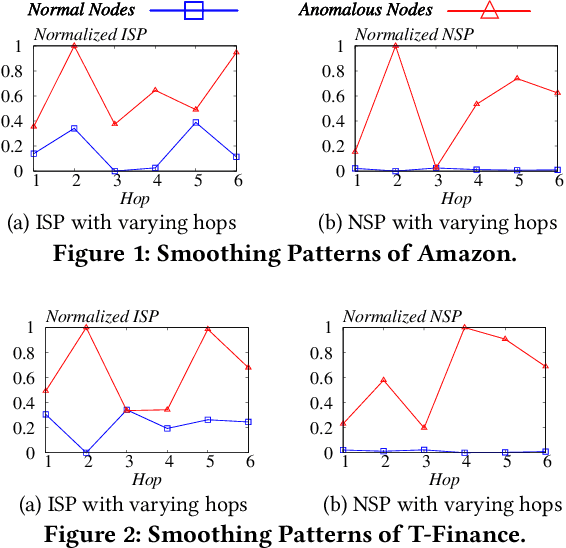
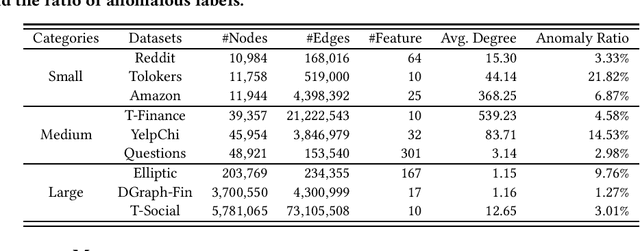
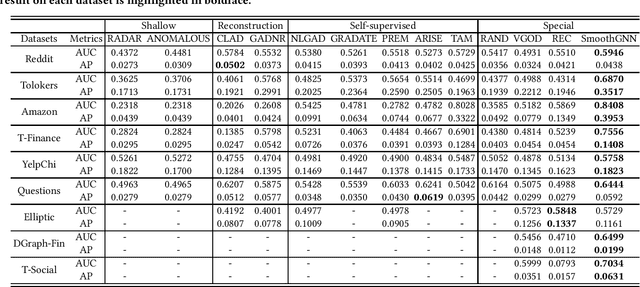

Abstract:The smoothing issue leads to indistinguishable node representations, which poses a significant challenge in the field of graph learning. However, this issue also presents an opportunity to reveal underlying properties behind different types of nodes, which have been overlooked in previous studies. Through empirical and theoretical analysis of real-world node anomaly detection (NAD) datasets, we observe that anomalous and normal nodes show different patterns in the smoothing process, which can be leveraged to enhance NAD tasks. Motivated by these findings, in this paper, we propose a novel unsupervised NAD framework. Specifically, according to our theoretical analysis, we design a Smoothing Learning Component. Subsequently, we introduce a Smoothing-aware Spectral Graph Neural Network, which establishes the connection between the spectral space of graphs and the smoothing process. Additionally, we demonstrate that the Dirichlet Energy, which reflects the smoothness of a graph, can serve as coefficients for node representations across different dimensions of the spectral space. Building upon these observations and analyses, we devise a novel anomaly measure for the NAD task. Extensive experiments on 9 real-world datasets show that SmoothGNN outperforms the best rival by an average of 14.66% in AUC and 7.28% in Precision, with 75x running time speed-up, which validates the effectiveness and efficiency of our framework.
KPG: Key Propagation Graph Generator for Rumor Detection based on Reinforcement Learning
May 21, 2024Abstract:The proliferation of rumors on social media platforms during significant events, such as the US elections and the COVID-19 pandemic, has a profound impact on social stability and public health. Existing approaches for rumor detection primarily rely on propagation graphs to enhance model effectiveness. However, the presence of noisy and irrelevant structures during the propagation process limits the efficacy of these approaches. To tackle this issue, techniques such as weight adjustment and data augmentation have been proposed. However, these techniques heavily depend on rich original propagation structures, thus hindering performance when dealing with rumors that lack sufficient propagation information in the early propagation stages. In this paper, we propose Key Propagation Graph Generator (KPG), a novel reinforcement learning-based rumor detection framework that generates contextually coherent and informative propagation patterns for events with insufficient topology information, while also identifies indicative substructures for events with redundant and noisy propagation structures. KPG consists of two key components: the Candidate Response Generator (CRG) and the Ending Node Selector (ENS). CRG learns the latent distribution from refined propagation patterns, filtering out noise and generating new candidates for ENS. Simultaneously, ENS identifies the most influential substructures within propagation graphs and generates training data for CRG. Moreover, we introduce an end-to-end framework that utilizes rewards to guide the entire training process via a pre-trained graph neural network. Extensive experiments conducted on four datasets demonstrate the superiority of our KPG compared to the state-of-the-art approaches.
Rayleigh Quotient Graph Neural Networks for Graph-level Anomaly Detection
Oct 05, 2023Abstract:Graph-level anomaly detection has gained significant attention as it finds many applications in various domains, such as cancer diagnosis and enzyme prediction. However, existing methods fail to capture the underlying properties of graph anomalies, resulting in unexplainable framework design and unsatisfying performance. In this paper, we take a step back and re-investigate the spectral differences between anomalous and normal graphs. Our main observation shows a significant disparity in the accumulated spectral energy between these two classes. Moreover, we prove that the accumulated spectral energy of the graph signal can be represented by its Rayleigh Quotient, indicating that the Rayleigh Quotient is a driving factor behind the anomalous properties of graphs. Motivated by this, we propose Rayleigh Quotient Graph Neural Network (RQGNN), the first spectral GNN for graph-level anomaly detection, providing a new perspective on exploring the inherent spectral features of anomalous graphs. Specifically, we introduce a novel framework that consists of two components: the Rayleigh Quotient learning component (RQL) and Chebyshev Wavelet GNN with RQ-pooling (CWGNN-RQ). RQL explicitly captures the Rayleigh Quotient of graphs and CWGNN-RQ implicitly explores the spectral space of graphs. Extensive experiments on 10 real-world datasets show that RQGNN outperforms the best rival by 6.74% in Macro-F1 score and 1.44% in AUC, demonstrating the effectiveness of our framework.
Why does Stereo Triangulation Not Work in UAV Distance Estimation
Jun 15, 2023



Abstract:UAV distance estimation plays an important role for path planning of swarm UAVs and collision avoidance. However, the lack of annotated data seriously hinder the related studies. In this paper, we build and present a UAVDE dataset for UAV distance estimation, in which distance between two UAVs is obtained by UWB sensors. During experiments, we surprisingly observe that the commonly used stereo triangulation can not stand for UAV scenes. The core reason is the position deviation issue of UAVs due to long shooting distance and camera vibration, which is common in UAV scenes. To tackle this issue, we propose a novel position correction module (PCM), which can directly predict the offset between the image positions and the actual ones of UAVs and perform calculation compensation in stereo triangulation. Besides, to further boost performance on hard samples, we propose a dynamic iterative correction mechanism, which is composed of multiple stacked PCMs and a gating mechanism to adaptively determine whether further correction is required according to the difficulty of data samples. Consequently, the position deviation issue can be effectively alleviated. We conduct extensive experiments on UAVDE, and our proposed method can achieve a 38.84% performance improvement, which demonstrates its effectiveness and superiority. The code and dataset would be released.
Logic-Consistency Text Generation from Semantic Parses
Aug 02, 2021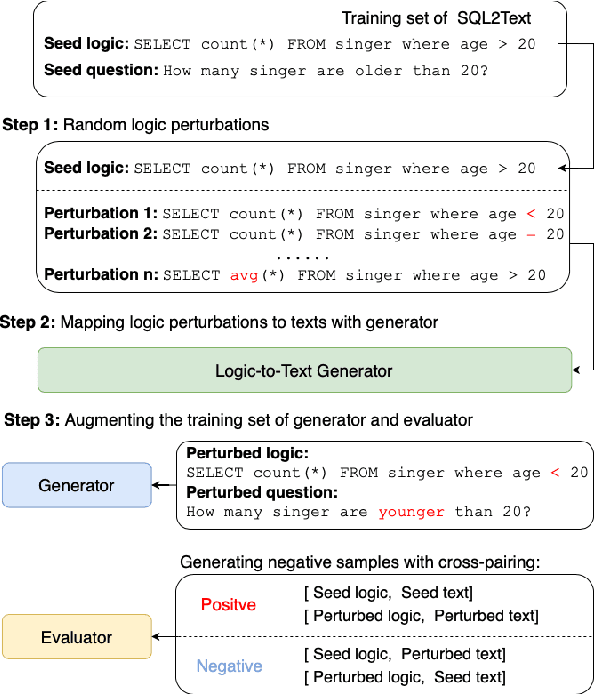
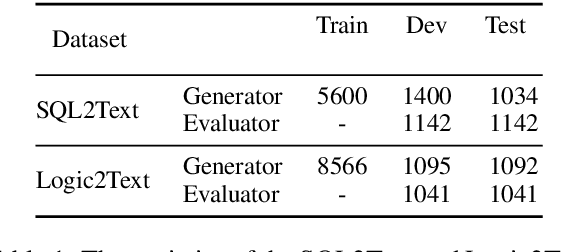

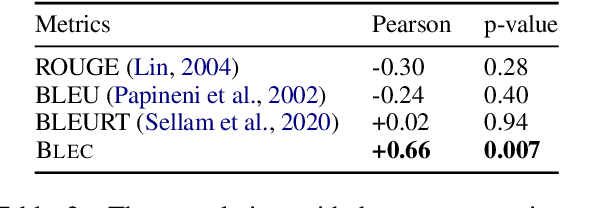
Abstract:Text generation from semantic parses is to generate textual descriptions for formal representation inputs such as logic forms and SQL queries. This is challenging due to two reasons: (1) the complex and intensive inner logic with the data scarcity constraint, (2) the lack of automatic evaluation metrics for logic consistency. To address these two challenges, this paper first proposes SNOWBALL, a framework for logic consistent text generation from semantic parses that employs an iterative training procedure by recursively augmenting the training set with quality control. Second, we propose a novel automatic metric, BLEC, for evaluating the logical consistency between the semantic parses and generated texts. The experimental results on two benchmark datasets, Logic2Text and Spider, demonstrate the SNOWBALL framework enhances the logic consistency on both BLEC and human evaluation. Furthermore, our statistical analysis reveals that BLEC is more logically consistent with human evaluation than general-purpose automatic metrics including BLEU, ROUGE and, BLEURT. Our data and code are available at https://github.com/Ciaranshu/relogic.
Did You Ask a Good Question? A Cross-Domain Question Intention Classification Benchmark for Text-to-SQL
Oct 23, 2020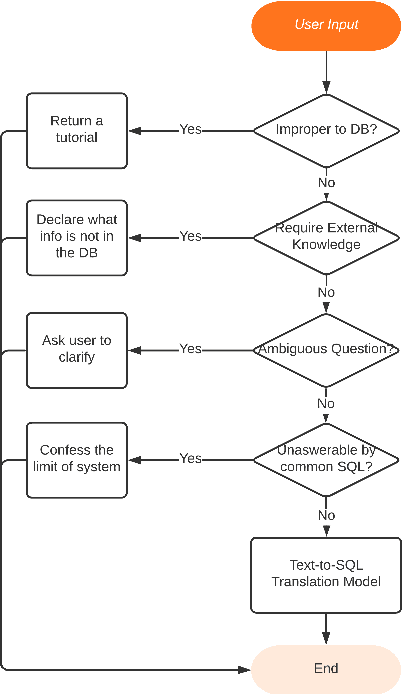


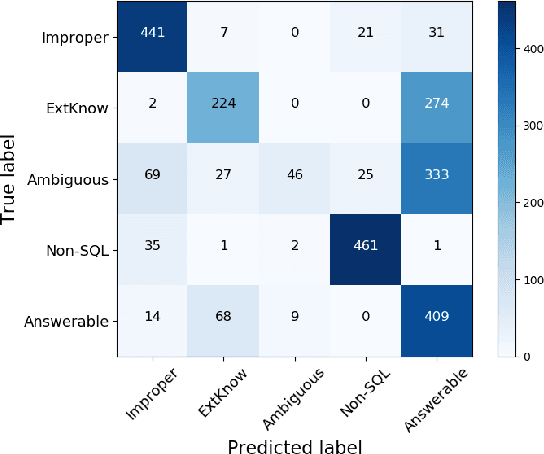
Abstract:Neural models have achieved significant results on the text-to-SQL task, in which most current work assumes all the input questions are legal and generates a SQL query for any input. However, in the real scenario, users can input any text that may not be able to be answered by a SQL query. In this work, we propose TriageSQL, the first cross-domain text-to-SQL question intention classification benchmark that requires models to distinguish four types of unanswerable questions from answerable questions. The baseline RoBERTa model achieves a 60% F1 score on the test set, demonstrating the need for further improvement on this task. Our dataset is available at https://github.com/chatc/TriageSQL.
 Add to Chrome
Add to Chrome Add to Firefox
Add to Firefox Add to Edge
Add to Edge